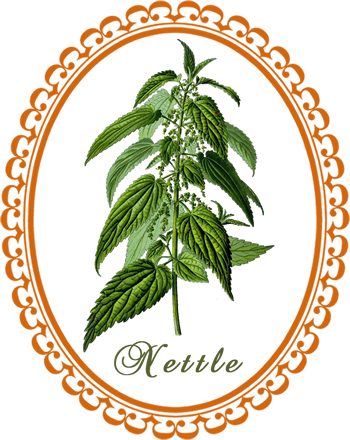
Nettle: taken therapeutically, nettle's energizing leaves stimulate the bladder and kidneys to ensure rapid removal of accumulated toxins ...
Common Names: Nettle, Stinging Nettle
Botanical Name: Urtica dioica
Family: Urticaceae
Plant Type: Hardy perennial
Parts Used: Flowers, leaves, stems, roots, fruit, seeds
Flowering: June
Native to Eurasia, nettle is a common invasive weed that inhabits the edges of woodlands, ditches, fields, waste places, and neglected gardens. It grows in temperate regions worldwide.
Description: Nettle is a tall (up to 5 feet), erect perennial herb with creeping roots, square stems, lance-shaped leaves with serrated edges, and clusters of small green flowers. All parts of the plant bristle with stinging hairs. Sometimes the male and female flowers are found on the same plant, but typically they are on separate plants.
Cultivation: Nettles grow wild and will happily sprout anywhere you don't weed.
Harvesting: Nettle can be cut in early summer before flowering. It will quickly regrow and three or four harvests of the above-ground parts is possible. Once dried or boiled, nettle loses its sting. Nettle roots are harvested in autumn. Be sure to wear gloves when harvesting nettle.
Culinary Uses: Steam or boil them lightly and serve with butter and lemon; or add to soups, stews, and broth for added flavor and nutrition. The sting disappears after it has been cooked. Nettles are an excellent source of iron and Vitamin C.
Nettle Magick
Exorcism. Protection. Healing. Lust.
Gender: Masculine
Planet: Mars
Element: Fire
Carry nettle with yarrow to allay fear.
Throw nettle into a fire to avert danger.
Sprinkle nettle around the house to keep evil out and to send it back.
Use nettle to remove a curse and send it back, stuff a poppet with nettle, or carry some in a sachet.
Strange but true ... when nettles come in contact with a part of the body that is already in pain, the chemicals the plant injects into the skin ease that original pain, partly by encouraging blood flow to the skin. It has been used in this manner for hundreds, if not thousands of years to treat rheumatism, arthritis, and similar painful conditions.
Herbal Healing with Nettle
Medicinal Actions: anti-allergenic, anti-hemorrhagic, astringent, diuretic, tonic
Medicinal Uses: Nettles are an excellent tonic for strengthening the entire system. Nettle preparations are used in treating rheumatism, preventing and treating kidney and bladder stones, and easing inflammation of the urinary tract. Dried roots or root extracts are suggested for treating the symptoms of enlarged prostrate (BPH). Nettle is also prescribed for anemia, hay fever, asthma and other allergic conditions, to rid the body of uric acid in treating gout, to stimulate circulation, to clear inflammatory skin conditions such as eczema, and to control uterine hemorrhage and heavy menstrual bleeding. Nettles are specific for the treatment of eczema, especially childhood eczema.
Body Care with Nettle
- As a cleansing body tonic, take 2 cups stinging nettle leaf infusion daily, as required.
- To ease gout, arthritis and rheumatism, drink 1 cup stinging nettle decoction up to three times daily, for as long as necessary.
- To reduce a benign swollen prostrate, take 2 or 3 size 00 capsules filled with stinging nettle root powder three times daily until the swelling subsides.
Infusion: 1 teaspoon dried or 2 teaspoons fresh stinging nettle leaves in 1 cup just-boiled water.
Decoction: 30 g (1 oz) dried or 60g (2 oz) fresh stinging nettle roots in 750 ml (3 cups) water.
Source: The Essential Herbs Handbook by Lesley Bremness
If you appreciate the information provided,
please help keep this website running. Blessings!
© 2008-2025 aromaworx.ca. All rights reserved.

